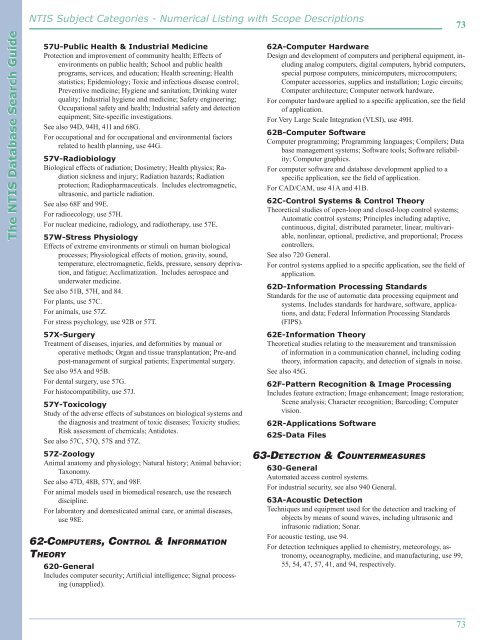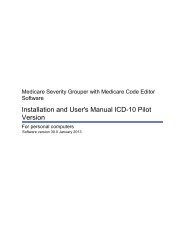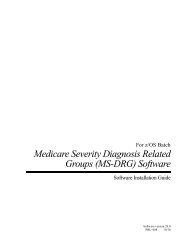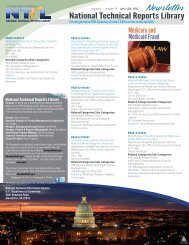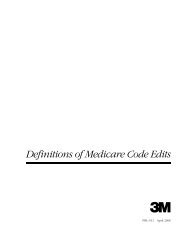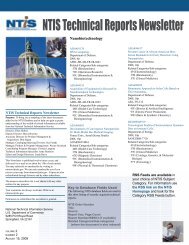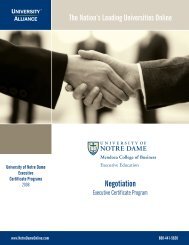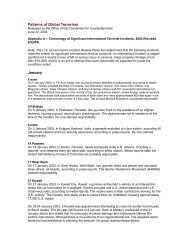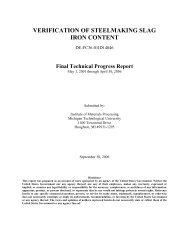DATABASE GUIDE - National Technical Information Service
DATABASE GUIDE - National Technical Information Service
DATABASE GUIDE - National Technical Information Service
You also want an ePaper? Increase the reach of your titles
YUMPU automatically turns print PDFs into web optimized ePapers that Google loves.
NTIS Subject Categories - Numerical Listing with Scope Descriptions7357U‐Public Health & Industrial MedicineProtection and improvement of community health; Effects ofenvironments on public health; School and public healthprograms, services, and education; Health screening; Healthstatistics; Epidemiology; Toxic and infectious disease control;Preventive medicine; Hygiene and sanitation; Drinking waterquality; Industrial hygiene and medicine; Safety engineering;Occupational safety and health; Industrial safety and detectionequipment; Site‐specific investigations.See also 94D, 94H, 41I and 68G.For occupational and for occupational and environmental factorsrelated to health planning, use 44G.57V‐RadiobiologyBiological effects of radiation; Dosimetry; Health physics; Radiationsickness and injury; Radiation hazards; Radiationprotection; Radiopharmaceuticals. Includes electromagnetic,ultrasonic, and particle radiation.See also 68F and 99E.For radioecology, use 57H.For nuclear medicine, radiology, and radiotherapy, use 57E.57W‐Stress PhysiologyEffects of extreme environments or stimuli on human biologicalprocesses; Physiological effects of motion, gravity, sound,temperature, electromagnetic, fields, pressure, sensory deprivation,and fatigue; Acclimatization. Includes aerospace andunderwater medicine.See also 51B, 57H, and 84.For plants, use 57C.For animals, use 57Z.For stress psychology, use 92B or 57T.57X‐SurgeryTreatment of diseases, injuries, and deformities by manual oroperative methods; Organ and tissue transplantation; Pre‐andpost‐management of surgical patients; Experimental surgery.See also 95A and 95B.For dental surgery, use 57G.For histocompatibility, use 57J.57Y‐ToxicologyStudy of the adverse effects of substances on biological systems andthe diagnosis and treatment of toxic diseases; Toxicity studies;Risk assessment of chemicals; Antidotes.See also 57C, 57Q, 57S and 57Z.57Z‐ZoologyAnimal anatomy and physiology; Natural history; Animal behavior;Taxonomy.See also 47D, 48B, 57Y, and 98F.For animal models used in biomedical research, use the researchdiscipline.For laboratory and domesticated animal care, or animal diseases,use 98E.62‐Computers, Control & <strong>Information</strong>Theory620‐GeneralIncludes computer security; Artificial intelligence; Signal processing(unapplied).62A‐Computer HardwareDesign and development of computers and peripheral equipment, includinganalog computers, digital computers, hybrid computers,special purpose computers, minicomputers, microcomputers;Computer accessories, supplies and installation; Logic circuits;Computer architecture; Computer network hardware.For computer hardware applied to a specific application, see the fieldof application.For Very Large Scale Integration (VLSI), use 49H.62B‐Computer SoftwareComputer programming; Programming languages; Compilers; Database management systems; Software tools; Software reliability;Computer graphics.For computer software and database development applied to aspecific application, see the field of application.For CAD/CAM, use 41A and 41B.62C‐Control Systems & Control TheoryTheoretical studies of open‐loop and closed‐loop control systems;Automatic control systems; Principles including adaptive,continuous, digital, distributed parameter, linear, multivariable,nonlinear, optional, predictive, and proportional; Processcontrollers.See also 720 General.For control systems applied to a specific application, see the field ofapplication.62D‐<strong>Information</strong> Processing StandardsStandards for the use of automatic data processing equipment andsystems. Includes standards for hardware, software, applications,and data; Federal <strong>Information</strong> Processing Standards(FIPS).62E‐<strong>Information</strong> TheoryTheoretical studies relating to the measurement and transmissionof information in a communication channel, including codingtheory, information capacity, and detection of signals in noise.See also 45G.62F‐Pattern Recognition & Image ProcessingIncludes feature extraction; Image enhancement; Image restoration;Scene analysis; Character recognition; Barcoding; Computervision.62R‐Applications Software62S‐Data Files63‐Detection & Countermeasures630‐GeneralAutomated access control systems.For industrial security, see also 940 General.63A‐Acoustic DetectionTechniques and equipment used for the detection and tracking ofobjects by means of sound waves, including ultrasonic andinfrasonic radiation; Sonar.For acoustic testing, use 94.For detection techniques applied to chemistry, meteorology, astronomy,oceanography, medicine, and manufacturing, use 99,55, 54, 47, 57, 41, and 94, respectively.73


